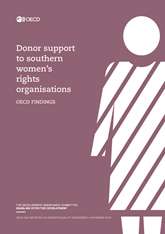Egalité homme-femme et développement
Donor support to southern women’s rights organisations: OECD findings
|
||
|
Ways forward 1. Reaching women’s rights organisations takes deliberate effort and an intentional approach that builds support for women’s groups into the structure of funding mechanisms.2. Better monitoring is needed of how much finance reaches southern women’s rights organisations – directly and indirectly, as core and project funding – and of the quality of this support. 3. Women’s movements require breath, depth and diversity. Donors can best fund this diversity using a mix of funding streams and mechanisms that allow partnerships with CSOs of different sizes and capabilities, working at different levels and on different issues. 4. Investing in the infrastructure of organisations and movements is the basics of sustainability, resilience and long-term change. This requires a long-term view of partnership that builds organisational capacity through multi-year core support. 5. Reaching the grassroots can be achieved by investing in specialist, well-anchored funding intermediaries, such as women’s funds. 6. A proactive approach is needed to reach beyond “usual suspects”. At the country level, donors should start by identifying local champions with a specialisation in women’s rights work. 7. Funding relationship-building, alliances and learning between women’s rights organisations, and with other social movements, is critical to strengthen collective voice, impact and sustainability. Donors can contribute by financing the co-ordination efforts required to build coalitions, investing in women’s CSO platforms and networks, and funding convenings. 8. Politically-informed and adaptive approaches improve the effectiveness of support to women’s rights organisations. 9. DAC donors should think big – beyond gender equality funds. The real win would be to influence large mainstream funds that can be hard for women’s rights organisations to access. 10. DAC members can use not only financial but also non-financial means, including engaging in policy dialogue to support safe and enabling environments in which women’s rights groups are able to thrive. |
Documents connexes
